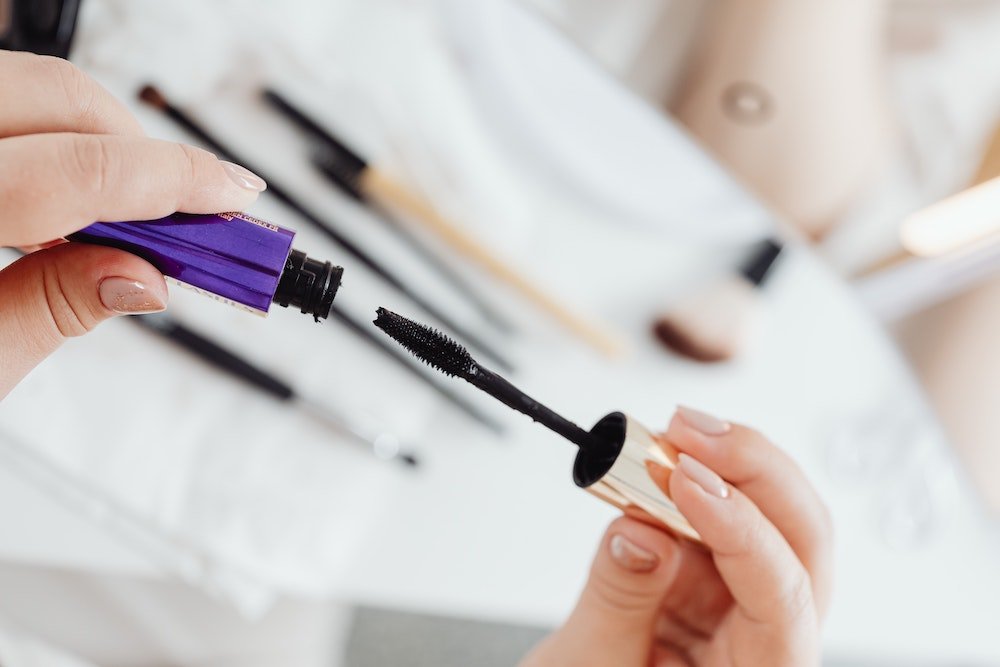PFAS (perfluoroalkyl and polyfluoroalkyl substances) constitute a large family of over 10,000 chemicals created in the 1950s to give water and fire resistance properties to different products. From food packaging to textiles, frying pans, and even cosmetics, they are omnipresent.
Considered as "forever chemicals," they are increasingly in the spotlight due to the disastrous consequences they have on our health and the environment.

PFAS in cosmetic products
100% derived from petrochemistry, PFAS are completely banned in organic cosmetics. So, why are they used in conventional cosmetics? What are the dangers?
Why are PFAS used in conventional cosmetics?
Some PFAS can be used as ingredients in certain cosmetic products such as makeup powders, mascaras, anti-aging treatments, or foundations.
They are notably used to make products last longer, preserve their color, or make them water-resistant.
NEW INFO PFAS - 4 APRIL 2024
A law banning cosmetics and clothing products containing PFAS was unanimously adopted by the National Assembly on Thursday, April 4, 2024.
This is a significant victory, especially for the cosmetics market. 💪
Now, we just have to wait until May 30th to see if the Senate will adopt this bill!
How to tell if your cosmetic product has PFAS?
You can check and see if a cosmetic product contains PFAS by reading the INCI list on the back of your cosmetic product. The main PFAS you may find are the following:
- PTFE
- PERFLUORODECALIN
- PERFLUORONONYL DIMETHICONE
- POLYPERFLUOROMETHYLISOPROPYL ETHER
- METHYL PERFLUOROISOBUTYL ETHER
- PERFLUOROHEXYLETHYL TRIETHOXYSILANE
- PERFLUOROHEXANE
- POLYPERFLUOROETHOXYMETHOXY DIFLUOROETHYL PEG PHOSPHATE
By the way, PTFE is one of the ingredients include in our latest ad campaign "Distinguishing the real bio from the fake". You can learn more about it here (only in French).
What dangers have been linked to PFAS ?
PFAS are disastrous for the environment🌍
The PFAS family is a group of substances all containing carbon-fluorine bonds, which are among the most stable and therefore strongest chemical bonds - thus, they do not degrade in the environment. This is also why they are called "forever chemicals".
When released into the environment, they remain there and can be transported over very long distances: they are now found everywhere (water, air, soil...).
What risks to PFAS have on our health ? ❤️🩹
PFAS are strongly suspected to have proven health risks. In addition to accumulating in the environment, they also accumulate in humans and all living organisms through food and water. (They are even found in polar bears!)
Most PFAS are both lipophobic and hydrophobic and therefore preferentially accumulate in the blood or organs.
Analysis of blood samples taken from a large panel of pregnant women showed that 100% of the samples contained significant concentrations of PFAS[1]. This same study also revealed that the higher the level of PFAS found in the maternal serum during a screening, the lower the birth weight and the smaller the head circumference of these babies.

From a general point of view, the human toxicity of PFAS can manifest at different levels:
- Effects on the thyroid, liver,
- Effects on the nervous system (autism, hyperactivity),
- Effects on the reproductive system (reduced fertility),
- Carcinogenicity,
- Endocrine disruptors,
- Effects on the immune system of young children (allergies, asthma).
What do the authorities think about PFAS ?
The use of certain PFAS has been heavily regulated by various regulatory laws for a few years now. On top of that, a new law will potenitally be passed soon banning all PFAS from cosmetic products (normally taking effect in 2025.
PFOA and many other perfluorinated ingredients have been banned for cosmetic use since June 2020 (substances No. 1493, 1561, and 1636 of Annex II of Regulation (EC) No. 1223/2009 on cosmetic products).
And internationally ?
The Stockholm Convention (2001) has established the POP (Persistent Organic Pollutants) regulation, aimed at regulating persistent organic pollutants. This regulation prohibits the use of PFOS (perfluorooctanesulfonic acid) in the European Union since 2009, PFOA (perfluorooctanoic acid) since July 2020, and PFHxS (perfluorohexanesulfonic acid) since June 2022.
New Zeland recently passed a law banning PFAS for 2026 as well.
PFAS and European regulation :
- The REACH Regulation 1907/2006 (a regulation that secures the manufacturing and use of chemical substances in the European industry) prioritizes PFAS in its risk management. Also, on June 19, 2023, the European Commission notified a project aimed at banning the use of perfluorohexanoic acid (PFHxA), its salts, and related substances (a subgroup of PFAS), including in cosmetic products. The text is expected to be adopted by the end of 2023.
- On March 22, 2023, the European Chemicals Agency ECHA launched a public consultation on the proposal to restrict more than 10,000 PFAS submitted by the national authorities of Denmark, Germany, the Netherlands, Norway, and Sweden. It is open for six months.
- Directive 2020/2184 of December 16, 2020, on the quality of water intended for human consumption (EDCH) now includes 20 PFAS for which a concentration limit of 0.10 µg/L has been set for all of them. Similarly, Perfluorooctane Sulfonic Acid (PFOS) and its derivatives are now part of the list of priority substances of the Water Framework Directive, which implies their monitoring and the control of water quality.
- In France, the amended order of January 25, 2010, establishing the program for monitoring the state of water in application of Article R. 212-22 of the Environmental Code, provides for the monitoring of PFOS as well as other PFAS in aquatic environments. Also, in January 2023, the Ministry of Ecological Transition and Territorial Cohesion issued a ministerial action plan on PFAS with the following work axes:
- Establish standards on emissions and environments to guide public action.
- Advocate at the European level for a broad ban to eliminate risks associated with the use or marketing of PFAS
- Improve knowledge of emissions and contamination in environments, particularly aquatic environments, to reduce population exposure.
- Significantly reduce emissions from emitting industries.
- Transparency on available information.
- Mid-term integration into the "micropollutants" plan.
- April 4th : A law banning cosmetics and clothing products containing PFAS was unanimously adopted by the National Assembly on Thursday. A significant victory that we hope will be adopted by the Senate.
Our final word on PFAS
PFAS are disaster for the environment and human health. The only way to change things is to ban their use! Some countries are taking initiative, lets hope for a global change soon !
As for organic cosmetics, PFAS have been prohibited since the creation of the Cosmébio label.
Sources :
[1] K.J. Marks, A.J. Cutler, Z. Jeddy, K.Northstone. Maternal serum concentrations of perfluoroalkyl substances and birth size in British boys. Intern. J. Hyg. and Envir. Health, vol. 222, 5, 2019, p. 889–895.



